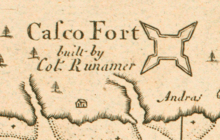Fort Loyal
| Fort Loyal | |
|---|---|
| Portland, Maine | |
|
Fort Falmouth on Falmouth Neck; map by Henry Barnsley, 1763 | |
| Type | Fort |
| Site information | |
| Controlled by | Great Britain |
| Site history | |
| Built | 1678 |
| In use | 1678-1690, 1742-1763, 1775-1783 |
| Materials | log palisade |
| Battles/wars | Battle of Fort Loyal |
| Garrison information | |
| Past commanders | Edward Tyng, George Lockhart, Sylvanus Davis, Moses Fowler, Abner Lowell |
| Garrison | 15 |
Fort Loyal was a British settler refuge and colonial outpost built in 1678 at Falmouth (present-day Portland, Maine) in Casco Bay. It was destroyed in 1690 by Abenaki and French forces at the Battle of Fort Loyal. The fort was rebuilt in 1742 and renamed Falmouth Fort before King George's War and rearmed again in 1755 for the French and Indian War. The fort was rebuilt a final time in 1775 for the American Revolution.[1]
The peninsula was first colonized by the English in 1632 as a fishing and trading village named Casco. When the Massachusetts Bay Colony absorbed the Province of Maine in 1658, the town's name changed to Falmouth. In 1676, the village was destroyed by the Abenaki during King Philip's War. English colonists returned two years later when peace resumed.
Fort Loyal was built in 1678 in the center of Portland at the foot of present-day India Street to protect the town from future attacks. In 1690 Fort Loyal consisted of four wooden blockhouses and eight guns. During King William's War, a raiding party of French and Native allies destroyed the English settlement and massacred its inhabitants in the Battle of Fort Loyal (1690).
The fort was rebuilt in 1742 and renamed "Falmouth Fort" before King George's War and then rearmed during the French and Indian War in 1755.[2]
Reverend Thomas Smith described the 1759 celebration at the fort in Falmouth upon the arrival of news that Quebec had fallen: "The cannon were fired at the fort yesterday and today. Mr. Mayhew's house was illuminated, and small arms fired in the evening, upon further and more authentic news of the victory at Quebec."[3]
Earthworks were constructed on the Fort Loyal site in 1775 as part of harbor defenses during the American Revolution and known as the "Lower Battery." Elements from earlier iterations of the fort, such as the guard house, were still in use. The bluff on which the fort had been located was leveled off during the construction of the Grand Trunk Railway in the 1850s. Today the fort's location is memorialized by a plaque on the Grand Trunk Office Building at the corner of India and Thames Streets in Portland.[4]
Fort New Casco

After the destruction of Fort Loyal, Massachusetts built a palisaded fort in Falmouth, Maine on Casco Bay in 1698 after the conclusion of King William's War. Fort New Casco was built at the behest of local Abenaki who desired a convenient place to trade and repair tools, while the British sought to foster better relations with the Indians and pull them away from the French sphere of influence. A 1701 meeting between local Abenaki-Pequawket and Massachusetts officials cemented an alliance between the two. A pair of stone cairns were then erected to symbolize the new partnership. The nearby Two Brothers Islands later received their name from this now long-forgotten monument.[5]
Unfortunately this peace would last less than three years, with the inauguration of Queen Anne's War in 1702. Governor Joseph Dudley held a conference at New Casco with representatives of the Abenaki tribes on June 20, 1703, trying to convince them not to ally with the French.
His efforts were unsuccessful, as the fort was besieged only two months later by Abenaki chiefs Moxus, Wanungonet, Assacombuit and their French Allies in the Northeast Coast Campaign (1703). John March was the commander of the fort.[6] vastly outnumbered English were relieved by the armed vessel "Province Galley", which dispersed the Abenaki and the some 500 French with its guns. The natives killed 25 English and took many others prisoner.[7]
Major Samuel Moody became the commander of the fort in 1707.[8]
Peace returned in 1713 with the Treaty of Portsmouth. When the resettlement of present-day Portland began in 1716, the Province of Massachusetts ordered that the fort at New Casco be demolished rather than maintain it.Fort New Casco's site today lies opposite Pine Grove Cemetery on Route 88.[9]
References
- ↑ Robert B. Roberts, Encyclopedia of Historic Forts: The Military, Pioneer, and Trading Posts of the United States, Macmillan: New York, 1988, 10th printing, ISBN 0-02-926880-X, page 367
- ↑ William Willis, History of Portland, 431.
- ↑ The last mention of the fort I could find: W.M. Willis, Journals of the Rev. Thomas Smith and the Rev. Samuel Deane(Portland: 1849), 74.
- ↑ Nathan Goold, "Falmouth Neck in the Revolution" in Collections and Proceedings of the Maine Historical Society, second series, vol. III (Portland, 1897), 85.
- ↑ http://w3.salemstate.edu/~ebaker/earthfast/earthfastpaper.html
- ↑ William Willis. History of Portland, p. 313
- ↑ William Willis. History of Portland, p. 312
- ↑ William Willis, p. 317
- ↑ George J. Varney, Gazetteer of the State of Maine (Boston: 1881), 226-8.
